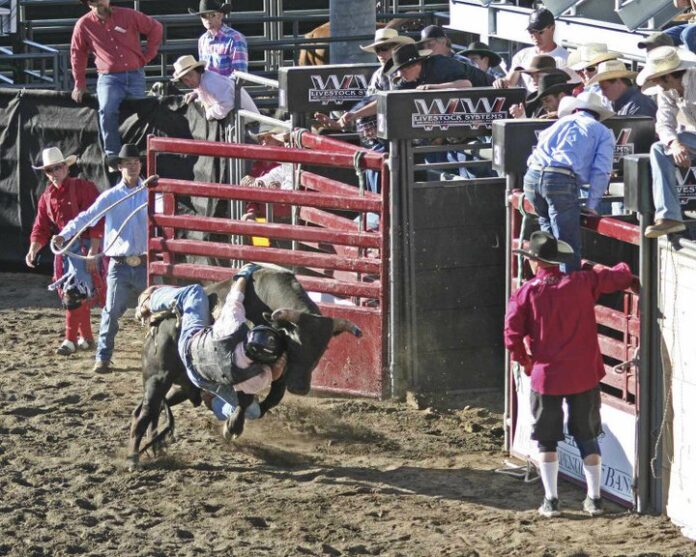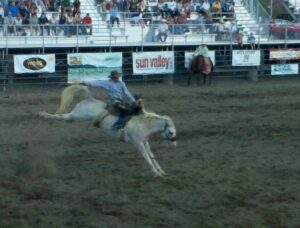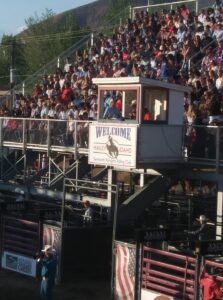
‘Days Of The Old West’ Festivities Include Three Nights Of Roping And Riding
BY Mark Dee

The Sawtooth Rangers get back in the saddle from July 2-4 for another running of Hailey’s “Days of the Old West” Rodeo, a Fourth of July tradition dating back nearly 80 years.
This year’s roundup opens with pre-event mutton busting on Wednesday, July 2, and wraps with hometown bull riding after the main competition on July 4. In between, expect three nights of high-end roping and riding—plus some down-home festivities—at the Hailey Rodeo Grounds.
Pre-show activities start at 6 p.m. nightly, with the main event following at 7:30 p.m.

Tickets aren’t available at the gate but are already open for presale. You can buy them in person at Atkinsons’ grocery stores, or the Hailey Welcome Center; tickets run $12 for adults and $7 for children. Alternatively, head online to www.SawtoothRangers.org and follow the link; digital tickets cost about $5 more than the in-person option.
Proceeds support the Sawtooth Rangers Riding Club and its local partners, including 4-H, youth rodeo and horsemanship throughout the community.
Looking to get your boots dirty? Registration is open online for children’s mutton busting on Wednesday and Thursday, and adult bull riding on Friday. Go online for more information.
Is this your first rodeo? No problem. Here’s a primer on the nine events that make up the competition, with insights from the Sawtooth Rangers.
Bull Riding: The name says it all: Wrap a rope around a bull’s torso, grab the loose end and hang on. Eight seconds earns a score, half determined by the human’s performance and half by the animal’s. “Size, agility and power create a danger that makes bull riding a crowd favorite everywhere,” the Rangers write on their website. “Balance, flexibility, coordination, quick reflexes and, perhaps above all, a strong mental attitude, are the stuff of which good bull riders are made.”
Steer Wrestling: Known as a “bulldogger,” a steer wrestler’s job is to literally take the bull by the horns. From horseback, a cowboy catches the steer, dismounts, and slams the brakes to stop or turn the animal. Then, he pins the 200-plus-pound cow to the ground. Ideally, it all happens fast: The world record stands at 2.4 seconds.
Saddle Bronc: Based on breaking horses at cattle ranches, saddle bronc is a more technical riding event. Holding a single rein, the cowboy must “mark out” their horse by touching spurs above the animal’s shoulders as it makes its first leap out of the gate. From there, stay in the saddle and keep it smooth: “While the bucking ability of the horse is naturally built into the scoring system, a smooth, rhythmic ride is sure to score better than a wild, uncontrolled effort,” the Rangers say.
Bareback Riding: Bareback does away with a saddle in favor of a minimalist cowhide rigging—basically, “a suitcase handle on a strap,” according to the Rangers. A rider grabs it with one hand, “marks out” the horse with his spurs and tries to ride for the eight seconds necessary to receive a score. Done right, it looks like the rider is reclining on a bucking bronco. The horse counts for half the points; the rest is up to the cowboy, judged on style, spurring technique, and “exposure” to the strength of the stock.
Barrel Racing: Usually decided by hundredths of a second, this speed event sees a rider enter the arena at a full sprint and work a clover-leaf pattern around three barrels. The key here is a clean run—it’s a five second penalty to knock over a barrel, sure to take a racer out of the money.
Tie-down Roping: Giving the calf a head start, the cowboy runs it down on horseback, ropes it, dismounts and ties any three legs together with a “pigging string”—a short loop of rope he holds in his teeth during the first leg. The calf must stay roped for six seconds; if it kicks free, no score is given. This takes place every day out on the ranch—it’s how hands restrain cattle to brand or examine them.
Breakaway Roping: A relatively new women’s event, breakaway is like tie-down roping without the tying-down. Fixing her lasso to the horn of her saddle with a thin string, she chases down a sprinting calf and throws the loop over its neck. Then, the rider signals the horse to stop; the calf pulls the rope taught, snaps the string, and ends the run. Fastest time wins.
Team Roping: Working together, two ropers—a header and a heeler—must catch a steer as fast as they can. First, the header throws a line around the head, neck or neck. Then, the heeler gets its two hind feet. (Improper catches incur penalties, and misses are disqualifying.) Once secure, the two horses face each other and pull the line taught to stop the clock. “Heading horses are generally taller and heavier, because they need power to turn the steer after it is roped,” the Rangers said. “Heeling horses are quick and agile, enabling them to better follow the steer and react to its moves.”


